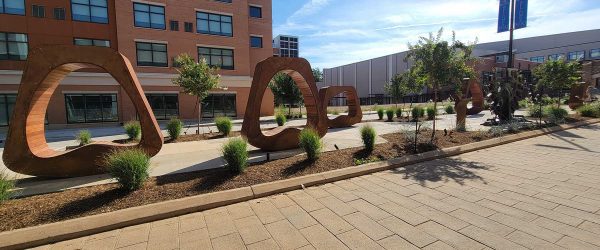Architecture professor’s plaza design activates heart of Rock Hill

At one time, more American flags were printed in Rock Hill, South Carolina, than in any place in the world. The Rock Hill Printing and Finishing Company, which opened in 1929, was one of the largest cloth printing and finishing companies in the United States and the center of that patriotic production during World War II. It was also, said Stephen Turner, “the biggest business concern that has ever existed in the city of Rock Hill.”
Called The Bleachery, because bleaching cloth is the first stage in the printing process, the company employed almost 5,000 people at its height in the mid-1960s — a third of the town’s adult population — and thus “played an outsized role in the life of the community,” said Turner, retired director of Economic and Urban Development for the city of Rock Hill .
The Bleachery closed in the 1990s, but Turner, who is a self-described “local history buff,” felt that the company’s economic and geographic prominence warranted ongoing recognition that would preserve the history beyond living memory. After years of planning and hard work, The Bleachery Heritage Project is finally coming to fruition through a design and fabrication process led by Associate Professor of Architecture Rachel Dickey with a team of architecture students and collaborators.
In 2020 Dickey won the commission to design a plaza in what is now called University Center, because of its proximity to Winthrop University, after Turner successfully secured an Our Town Grant from the National Endowment for the Arts and matching funds from the city. He and an advisory committee that included former Bleachery employees chose Dickey’s design through a Request for Proposals process that drew submissions from across the Southeast.
“Ultimately the team was impressed with Rachel’s concepts,” Turner said. “She built 3-D models and brought them to the interviews. Rachel’s concept was to really activate the space, invite people into the space. I don’t think any of the other proposals had that thought. Everybody loved her design.”
Many hands
Dickey’s final design is the product of widespread collaboration.
“There are a lot of hands in this project,” she said.
As is her custom with all of her public commissions and research projects, Dickey hired architecture students as research assistants. For two and half years, seven students — undergraduate and graduate — worked on the development and fabrication of the plaza elements.
“I couldn’t do what I do without the teams of students. It is very much my approach when I take on these projects. If we can find more ways for student employment that is productive to their education, that’s a good thing,” Dickey said.
She also enlisted the help of her colleague Nadia Anderson, associate professor of architecture and urban design, and the City Building Lab to connect with local community members in the fall of 2020.
A storytelling workshop produced oral histories with former Bleachery employees that can be heard via QR codes on the plaza’s signage. At a programming workshop, a community member came up with the idea of stamping the concrete walkway with patterns reminiscent of printed cloth. Art students at Rock Hill’s Southpoint High School analyzed historic fabric patterns and then created their own designs, which informed the imprints on the plaza’s path.
Sierra Grant, who completed her Bachelor of Arts in Architecture in 2021 and will graduate with a master’s degree in May, worked on the project for more than a year, both in design development and fabricating the rockers.
“I think that all of us are really happy with the way the Rock Hill plaza came out,” she said. “There were plenty of trials and errors when it came to the design process and actually getting the rockers to rock, but in the end it all worked out. It’s always exciting to work through issues with the team and then see the design come to life when it’s installed.”
Read the entire story, which features a video of The Bleachery Heritage Project, on the College of Arts + Architecture website.